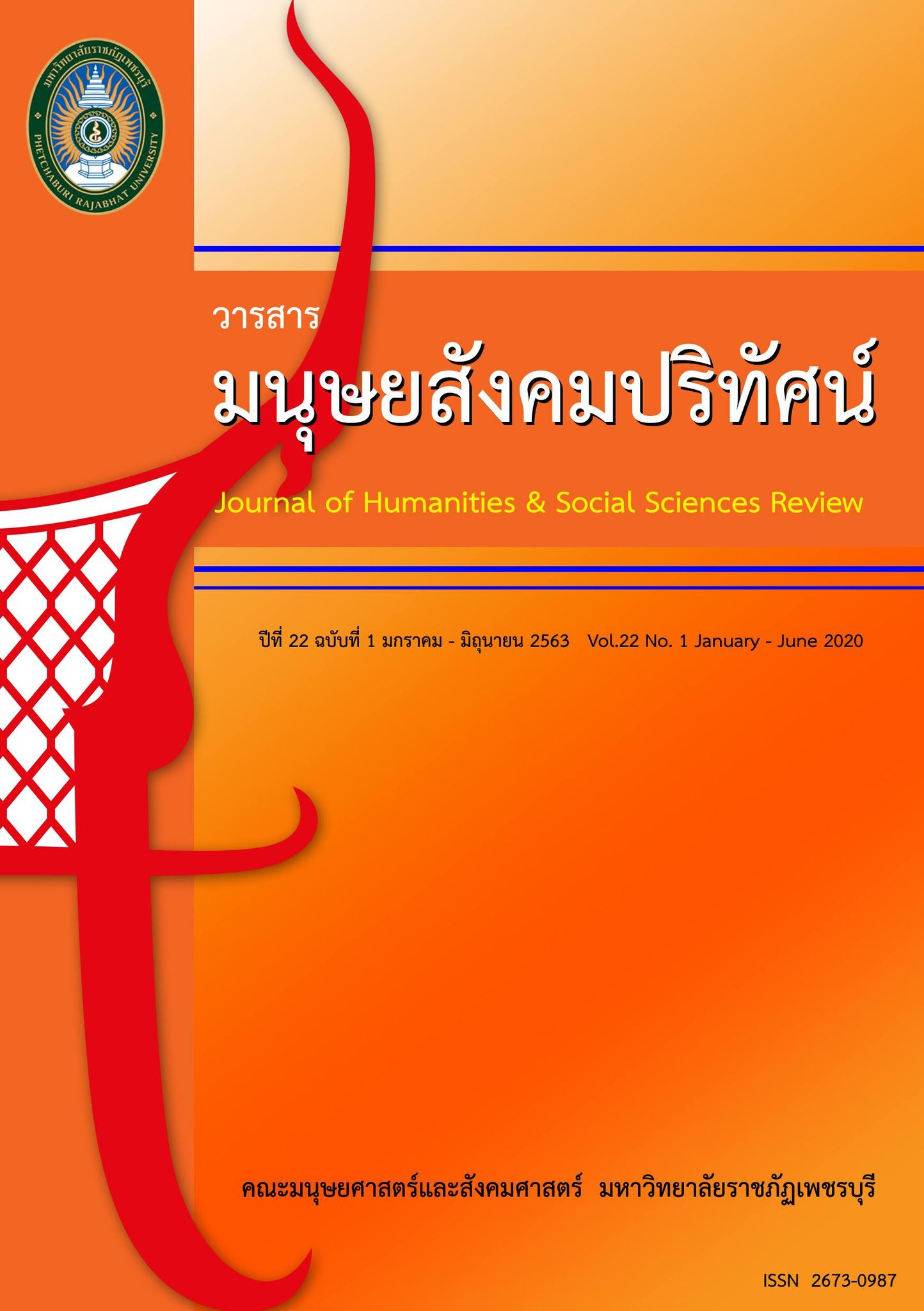การดำเนินงานในเครือข่ายธุรกิจเสื้อผ้ามือสอง
Main Article Content
บทคัดย่อ
การวิจัยครั้งนี้มีวัตถุประสงค์เพื่อศึกษา 1) ข้อมูลทั่วไปของธุรกิจเสื้อผ้ามือสอง 2) การดำเนินงานในเครือข่ายธุรกิจเสื้อผ้ามือสอง การวิจัยครั้งนี้เป็นงานวิจัยเชิงคุณภาพ กลุ่มผู้ให้ข้อมูลเป็นผู้ประกอบธุรกิจเสื้อผ้ามือสอง คือ ผู้นำเข้า ผู้ค้าส่ง ผู้ค้าปลีกรายย่อย และผู้บริโภค ซึ่งเก็บรวบรวมข้อมูลด้วยวิธีการสัมภาษณ์แบบกึ่งโครงสร้าง การสังเกตการณ์แบบไม่มีส่วนร่วม เอกสารงานวิจัยที่เกี่ยวข้องและแหล่งข้อมูลอื่น ๆ และนำข้อมูลที่ได้มา วิเคราะห์ข้อมูลเชิงเนื้อหา และนำเสนอผลการศึกษาในรูปแบบการพรรณนาความ
ผลการศึกษาพบว่า 1) เสื้อผ้ามือสองมีแหล่งใหญ่ที่รับเสื้อผ้ามือสองมาจำหน่าย คือ โกดังนำเข้า ตลาดโรงเกลือ และตลาดขายส่ง ซึ่งจะขายส่งแบบราคาเหมาเป็นร้อยตัวขึ้นไป ทัศนคติของผู้บริโภคที่มีต่อเสื้อผ้ามือสองคือ ราคาเสื้อผ้ามือสองถูกกว่าเสื้อมือหนึ่งและคุณภาพไม่ต่างจากสินค้ามือหนึ่งและพฤติกรรมของผู้บริโภคจากคุณภาพที่ไม่ต่างจากสินค้ามือหนึ่ง ลูกค้ายอมจ่ายเพราะช่วยประหยัดค่าใช้จ่ายได้ และ 2) เครือข่ายของธุรกิจเสื้อผ้ามือสอง เริ่มจากการนำเข้าเสื้อผ้ามือสองจากต่างประเทศมาจำหน่ายเป็นลักษณะกระสอบในประเทศไทย มีกลุ่มลูกค้าหลักคือ ผู้ค้าส่งและผู้ค้าปลีก ผู้ค้าส่งจะหาแหล่งที่นำเข้าและซื้อมาจำหน่ายเป็นกระสอบ ส่วนผู้ค้าปลีกจะทำการซื้อสินค้ายกกระสอบและไปคัดเอง โดยหาร้านค้าส่งจากหลายที่เพื่อหาเสื้อผ้าประเภทที่ต้องการขาย สินค้าที่นิยมจำหน่ายเป็นกลุ่มประเภทเสื้อยืดเหมือนการขายส่ง ส่วนมากจะจำหน่ายในตลาดนัด ถนนคนเดิน และเปิดขายทางช่องทางออนไลน์ พร้อมด้วยโปรโมชั่นการลดราคาเมื่อซื้อเป็นจำนวนมาก ความเสี่ยงของการทำธุรกิจนี้ คือ การแข่งขันกันในตลาดเดียวกัน ความเสื่อมสภาพของสินค้าที่เก็บรักษาในโกดังสินค้า กระแสความนิยมของผู้บริโภคและสภาวะเศรษฐกิจที่เปลี่ยนแปลง ซึ่งการวิจัยครั้งนี้สามารถนำผลการศึกษาไปใช้เป็นแนวทางในการบริหารและพัฒนา การดำเนินงานธุรกิจเสื้อผ้ามือสองหรือธุรกิจสินค้ามือสองอื่นๆ ให้มีประสิทธิภาพและประสบความสำเร็จต่อไป
Article Details
1. มุมมองและความคิดเห็นใด ๆ ในบทความเป็นมุมมองของผู้เขียน คณะบรรณาธิการไม่จำเป็นต้องเห็นด้วยกับมุมมองเหล่านั้นและไม่ถือเป็นความรับผิดชอบของคณะบรรณาธิการ ในกรณีที่มีการฟ้องร้องเกี่ยวกับการละเมิดลิขสิทธิ์ ให้ถือเป็นความรับผิดชอบของผู้เขียน แต่เพียงผู้เดียว
2. ลิขสิทธิ์บทความที่เป็นของคณะมนุษยศาสตร์และสังคมศาสตร์ มหาวิทยาลัยราชภัฏเพชรบุรีมีลิขสิทธิ์ถูกต้องตามกฎหมาย การเผยแพร่จะต้องได้รับอนุญาตโดยตรงจากผู้เขียนและมหาวิทยาลัยราชภัฏเพชรบุรีเป็นลายลักษณ์อักษร
เอกสารอ้างอิง
กิตติพันธ์ คงสวัสดิ์เกียรติ. (2554). การจัดการความเสี่ยงและตราสารอนุพันธ์เบื้องต้น (พิมพ์ครั้งที่ 4). กรุงเทพฯ: เพียร์สันเอ็ดดูเคชั่น อินโดไชน่า.
จันทนา สาขากร และคณะ. (2551). การควบคุมภายในและการตรวจสอบภายใน (พิมพ์ครั้งที่ 2). กรุงเทพฯ : คณะพาณิชยศาสตร์และการบัญชี มหาวิทยาลัยธรรมศาสตร์.
เจริญ เจษฎาวัลย์. (2546). การบริหารความเสี่ยง. กรุงเทพฯ: พอดี.
ฉัตยาพร เสมอใจ. (2550). พฤติกรรมผู้บริโภค. กรุงเทพฯ: ซีเอ็ดยูเคชั่น.
พิชามญชุ์ มะลิขาว. (2554). ปัจจัยที่ส่งผลต่อพฤติกรรมการชื้อเสื้อผ้าแฟชั่นสตรีผ่านสื่อสังคมออนไลน์เฟซบุ๊ค. การค้นคว้าอิสระบริหารธุรกิจมหาบัณฑิต สาขาบริหารธุรกิจ บัณฑิตวิทยาลัย มหาวิทยาลัยเทคโนโลยีราชมงคลธัญบุรี.
มนตรี ศรีวงษ์. (2559). รวมข้อดี ข้อเสีย ของการขายสินค้ามือ 2. สืบค้นเมื่อ 29 มิถุนายน 2563, จาก http://www.thaismescenter.com/รวมข้อดี-ข้อเสีย-ของการขาย-สินค้ามือ-2/.
ศุภิสรา แสงฤทธิ์. (2558). การศึกษาธุรกิจนำเข้าสินค้ามือสองจากญี่ปุ่น กรณีศึกษาโกดังสินค้ามือสองนำเข้าจากญี่ปุ่นในจังหวัดเชียงใหม่. วิทยานิพนธ์ศิลปศาสตรบัณฑิต สาขาภาษาญี่ปุ่น ภาควิชาภาษาตะวันออก คณะมนุษยศาสตร์ มหาวิทยาลัยเชียงใหม่.
สุกัญญา มุกดามนต์. (2552). ผ้ามือสอง: สะท้อนวิถีชีวิตของคนในสังคมเมืองปัตตานี. คณะศิลปกรรมศาสตร์ มหาวิทยาลัยสงขลานครินทร์.
สุเมษ เลิศจริยพร. (2557). การเรียนรู้วิธีดำเนินธุรกิจนำเข้า-ส่งออกครบวงจร. กรุงเทพฯ:จุฬาลงกรณ์มหาวิทยาลัย.
Crosby, P.B. (1979). Three Experts on quality management. Arlington, VA.: Dept. of the Navy TQL Office.
Kotler, P. (2003). Marketing management (11th ed.). Upper Saddle River, NJ: Prentice–Hall.
Kotler, P., and Keller, K. L. (2012). Marketing management (14th ed.). Boston: Prentice Hall.
O’Donnell, A. (2004). The nature of networking in small irms. Qualitative Market Research: An International Journal, 7(3), 206-217.
Perez, P. M., & Sanchez, A. M. (2002). Lean production and technology networks in the Spanish automotive supplier industry. Management International Review, 42(3), 261-277.
Rogers, D. (1978). The psychology of adolescence. New York: Appleton Century-Crofts.
Schiffman, L.G., & Kanuk, L.L. (1994). Consumer behavior (5th ed.). Englewood Cliffs, N.J.: Prentice-Hall.


